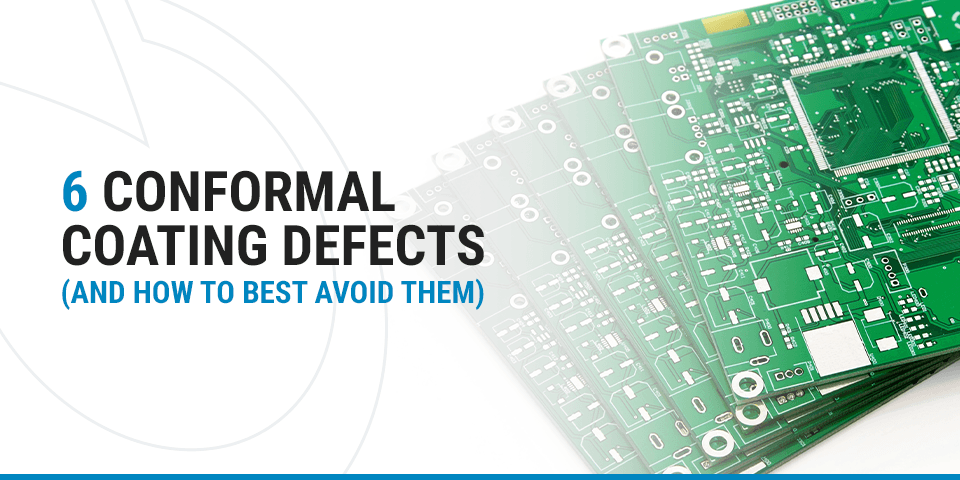6 Conformal Coating Defects (And How to Best Avoid Them)
Posted by Sean Horn
Friday, March 18, 2016 10:21
@ 10:21 AM

Conformal coatings are polymeric materials used to protect circuitry, parts, and related components. They are most commonly used to protect printed circuit boards (PCBs) and electronic devices.
However, conformal coatings can be applied to various materials, including metal, plastic, silicone, ceramics, glass, and even paper. We use the term “substrate” to refer to an object or material that’s been coated with a conformal coating.
Conformal Coating Costs
The price for conformal coating varies depending on the material being used and the preparation required. Raw parylene dimer, for example, can cost between $100 and $10,000+ per pound.
In many cases, however, the biggest cost of conformal coating is manual labor. Tasks such as cleaning, masking, and inspection take time and must be completed by a well-trained technician.
This distinction is essential for conformal coating production and inspection because repairing or reworking a failed coating is often costly.
The Cost of Defects and Rework
Depending on the material used, the process of removing a conformal coating might include using chemical solvents or thermal, mechanical, or microabrasion techniques.
Coatings made of acrylic, for example, are relatively easy to remove using chemical solvents. Parylene and epoxy coatings, on the other hand, are more challenging to remove. They usually require mechanical or microabrasion methods.
Whatever the material, the best way to keep your costs in line is to avoid these defects in the first place.

Conformal Coating Failure Mechanisms
All conformal coating failures either stem from the material selection or the process itself. It is crucial to select the right application method and conformal coating material. This guide will focus on the defects and rework caused when the right materials and application methods are misused.
Failure mechanisms in conformal coating processing are the typical problems you may encounter when applying and curing conformal coatings. Knowing why these failure mechanisms occur and, more importantly, how to prevent them can help you eliminate potential causes and reduce conformal coating costs.
6 Common Causes of Conformal Coating Defects and Rework
Here are the six most common causes of conformal coating defects we see, along with recommendations for how to avoid them:
1. Capillary Flow
Capillary flow is a type of coating migration that happens when a liquid conformal coating pulls away or “flows” from one area of the substrate to another. This usually occurs during the drying and curing process, resulting in a patchy, uneven finish. Some areas of the substrate may even be left completely uncoated.
The most common causes for capillary flow are:
- Low viscosity of the coating material
- High surface tension of the coating material
- Coating applied too thick to the substrate
- Low surface energy of the substrate
To avoid these problems:
- Ensure the substrate is clean before applying the coating
- Reduce the use of thinners to increase the viscosity
- Reduce the coating thickness
- Use a solvent-based coating instead of a water-based coating
- Heat the board before coating to help it dry more quickly
2. Cracking
Cracking happens when a smooth surface of coating fractures into sections. The cracks between the sections leave the area below exposed to potential contaminants. Because there is a higher risk of moisture, water, and debris reaching the board level, cracking could lead to other conformal coating defects.
Common causes for cracking are:
- High temperature during curing
- Coating curing too quickly
- Coating applied too thick to the substrate
- Insufficient drying time between coats
- Operating temperature too high or too low for coating specifications
To prevent cracking:
- Lower the cure temperature
- Allow additional drying time at room temperature
- Apply the coating to specified thickness levels
- Choose a coating with a wider effective temperature range
- Choose a more flexible coating
Generally, a staged evaporation rate is ideal for crack prevention. Use a lower cure temperature over a longer time if cracks persist in the substrate. Some coatings will benefit from a two-step accelerated cure, allowing the more volatile solvents to cure at a more controlled rate and lower temperature. Meanwhile, slower solvents are flashed off during a subsequent period of increased temperature.
3. De-Wetting
De-wetting occurs when a liquid conformal coating will not evenly coat the surface. Particular areas of the coating may bead up while others appear correctly applied. De-wetting usually happens because of nonionic contamination, often from the manufacturing, transport, or handling process.
When contaminants on the substrate are incompatible with the coating, it causes the surface to resist spreading in those areas. Generally, the conformal coating will bead up and move away from the following contaminants:
- Process oils
- Flux residues
- Mold-release agents
- Fingerprints
Whether contaminants appear on the substrate during assembly or are introduced during soldering, all must be removed with careful cleaning. The best way to prevent de-wetting is to ensure the substrate material is spotless before applying the conformal coating. Select low-residue materials to control the process more effectively.
4. Delamination
Delamination happens when a conformal coating lifts away from the substrate, leaving the area below it exposed. Loss of adhesion between the conformal coating and substrate can lead to partial or complete lifting. In most cases, delamination is not immediately observed and only noticed once the part is in use. That’s why prevention is vital for this defect.
Delamination is most often caused by:
- Contaminants on the surface of the substrate
- Lack of compatibility between the coating and the substrate material
- Coating applied too thick to the substrate
- Moisture between the coating and the laminate
- Improper curing of the conformal coating
- Insufficient drying time between coats
To help prevent delamination:
- Clean the board thoroughly before coating it
- Choose a different coating material
- Reduce the coating thickness
- Reduce force drying
- Choose a less permeable coating material
- Allow adequate time between coats
- Apply a “primer” material known to bond with the substrate and the conformal coating material
5. Orange Peel
Orange peel happens when the coating is uneven and textured, often appearing dull and very similar to the skin of an orange. Mottled textures in the conformal coating may prove to be cosmetic and non-critical. However, they usually indicate a process flaw that must be modified.
There can be multiple causes for orange peel:
- Improper application of the coating materials
- High viscosity of the coating material from incorrect thinners
- Insufficient coating applied to the substrate
- Coating applied too thick to the substrate
- Not enough time curing
- Low air pressure leading to uneven atomization
To mitigate the effect of orange peel:
- Optimize the spraying technique to manufacturer specifications
- Choose a different thinner to reduce the viscosity
- Apply the coating to the recommended thickness
- Increase the “flash-off time” for the solvents to evaporate before turning up the temperature to speed the curing process
6. Bubbles, Pinholes, and Foam
Bubbles happen when pockets of air become trapped under a layer of conformal coating. They commonly occur when the coating fails to level and adhere to the substrate. Applying conformal coating with a brush may also create bubbles in the hardening surface.
Pinholes occur when a bubble bursts through the coating layer. Meanwhile, foam is a form of extreme bubbling. While bubbles and foam may be non-critical, they could exacerbate deterioration of the coating. These effects will also reduce the level of protection provided to the circuit board and may indicate problems with the process.
Common causes of bubbles and foam are:
- Contaminants on the surface of the substrate
- Coating applied too thick to the substrate
- High viscosity of the coating material
- High temperature during curing
- Coating cured too quickly
- Coating applied with incorrect equipment settings or pressure
To help prevent these problems:
- Ensure the coating is applied only to the recommended thickness
- Apply several thin coats, allowing bubbles to dissipate between layers
- Use a lower viscosity version of the conformal coating
- Blend coats applied with a brush so they flow easily into all areas of the substrate
The No. 1 Thing You Can Do to Prevent Coating Defects
The most effective way to prevent conformal coating failures is to ensure you’re working with an experienced provider.
Experienced technicians will know how to apply a wide variety of coatings without causing any of the problems we’ve discussed in this article. At Diamond-MT, our team of experts is committed to providing the high-quality, protective coatings and excellent service your project needs. Contact us to request a quote and get more information about our services.
Comments
Homepage 4/17/2020. 10:17:10 AM
... [Trackback] [...] Informations on that Topic: blog.paryleneconformalcoating.com/whats-the-difference-between-potting-and-conformal-coating/ [...]

londondrugscanada.bigcartel.comlondon-drugs 4/17/2020. 10:17:10 AM
cialis uk https://londondrugscanada.bigcartel.com/london-drugs This is nicely expressed. !